ANNIE555
Abstract
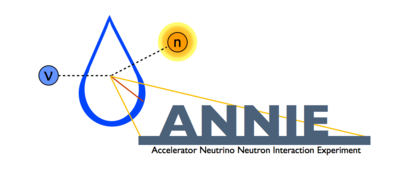 The goal of the Accelerator Neutrino Neutron Interaction Experiment, or ANNIE, is to provide a measurement of the neutron production rate in water Cherenkov detectors. With a volume of about 30 tons of Gadolinium-doped water, it will measure the neutron yield of neutrino interactions as a function of the neutrino energy in the well-characterized Booster Neutrino Beam at Fermilab. The modularity of ANNIE will allow it to perform the very first live test of a novel kind of photodetectors called LAPPDs (Large Area Picosecond Photodetectors) in a neutrino detector. The technology behind the ANNIE detector will have a noticeable impact on the development of future large water Cherenkov detectors as well as on photodetection techniques for neutrino physics.
The goal of the Accelerator Neutrino Neutron Interaction Experiment, or ANNIE, is to provide a measurement of the neutron production rate in water Cherenkov detectors. With a volume of about 30 tons of Gadolinium-doped water, it will measure the neutron yield of neutrino interactions as a function of the neutrino energy in the well-characterized Booster Neutrino Beam at Fermilab. The modularity of ANNIE will allow it to perform the very first live test of a novel kind of photodetectors called LAPPDs (Large Area Picosecond Photodetectors) in a neutrino detector. The technology behind the ANNIE detector will have a noticeable impact on the development of future large water Cherenkov detectors as well as on photodetection techniques for neutrino physics.
The ANNIE collaboration
 ANNIE is a joint experiment between universities and national laboratories in the United States of America and the United Kingdom: Fermi National Laboratory; University of California at Davis; Iowa State University; University of California at Irvine; University of Sheffield; Queen Mary University of London; Brookhaven National Laboratory; University of California at Berkeley; University of Chicago; Ohio State University
ANNIE is a joint experiment between universities and national laboratories in the United States of America and the United Kingdom: Fermi National Laboratory; University of California at Davis; Iowa State University; University of California at Irvine; University of Sheffield; Queen Mary University of London; Brookhaven National Laboratory; University of California at Berkeley; University of Chicago; Ohio State University
Physics goals
The observation of proton decay, a very rare process predicted by Grand Unification Theories, has been one of the main goals of large water Cherenkov detectors for more than three decades. The next generation of detectors, such as Hyper-Kamiokande, will allow physicists to probe a region where most modern GUT models tend to converge in terms of proton decay lifetime. However, with such large scales, most of these detectors will be subjected to a non-negligible rate of atmospheric neutrino interactions, considered backgrounds for proton decay searches. In order to reduce this background and successfully assess the observation of a proton decay event, one needs to differentiate these two processes using their final states. Indeed, while one or several neutrons are typically found in the final state of atmospheric neutrino interactions, no neutrons are expected following a proton decay. The ability to tag neutrons in WCh detectors would thus be considered a considerable milestone for proton decay searches. Other topics in neutrino physics, such as supernovae detection, could be highly impacted as well.
In addition, Long Baseline Experiments operating at the few GeV energy scale have a real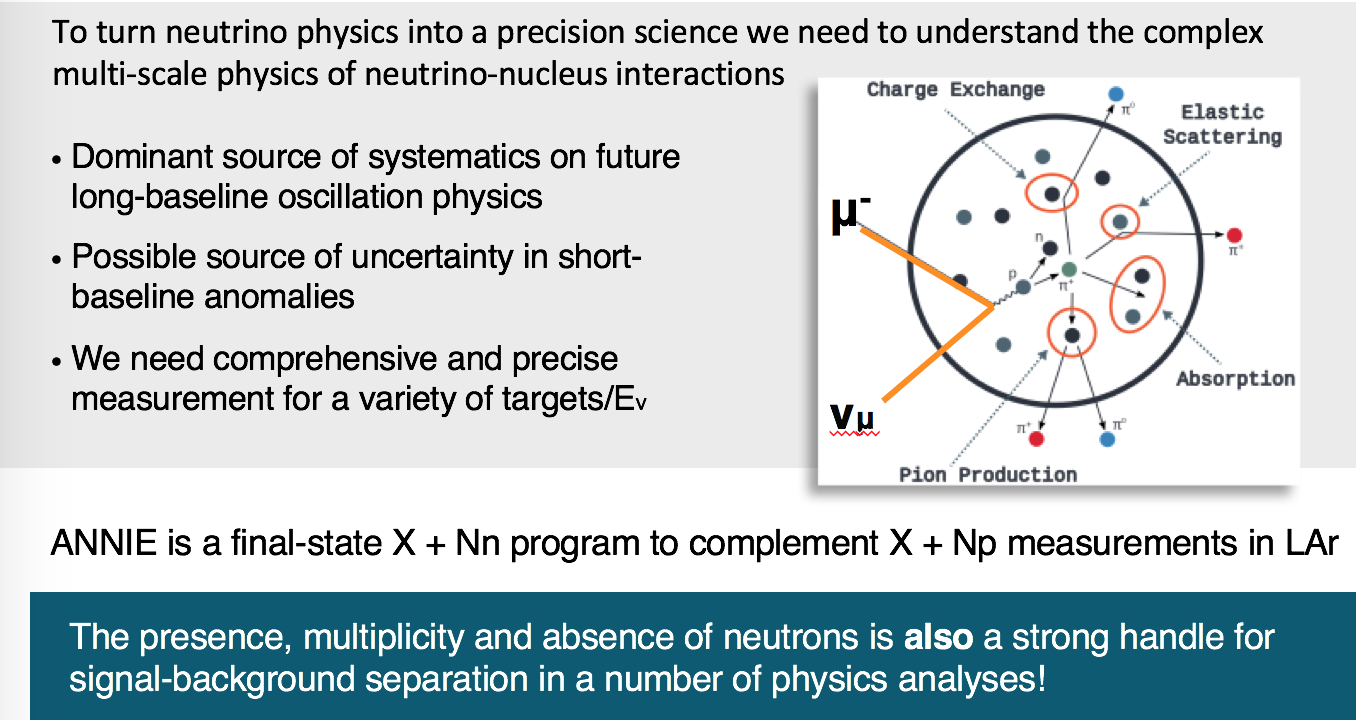 challenge in trying to understand the impact of the fact that at this energy nuclear effects are large. As the slide on the right describes, many internuclear processes conspire to produce outgoing nucleons and pions. While several experiments have measured proton emission following neutrino interactions at the energy (e.g. mini-BooNE and micro-BooNE), ANNIE will be the first to quantitatively measure neutron production as a function of the momentum transferred to the nucleus from the neutrino.
challenge in trying to understand the impact of the fact that at this energy nuclear effects are large. As the slide on the right describes, many internuclear processes conspire to produce outgoing nucleons and pions. While several experiments have measured proton emission following neutrino interactions at the energy (e.g. mini-BooNE and micro-BooNE), ANNIE will be the first to quantitatively measure neutron production as a function of the momentum transferred to the nucleus from the neutrino.
Components of the experiment
The ANNIE detector is located 100 meters downstream and on-axis of the Booster Neutrino Beam (BNB) target at Fermilab. Formerly occupied by the SciBooNE experiment, the experimental hall possesses the advantages of being subjected to an intense and focused neutrino beam while being already dug and immediately furnished and usable.
The ANNIE detector consists of three sub-detectors, each placed along the beam line and serving a particular purpose in order to select neutrino interactions and reject backgrounds.
The Front Anti Coincidence Counter (FACC, or forward veto)
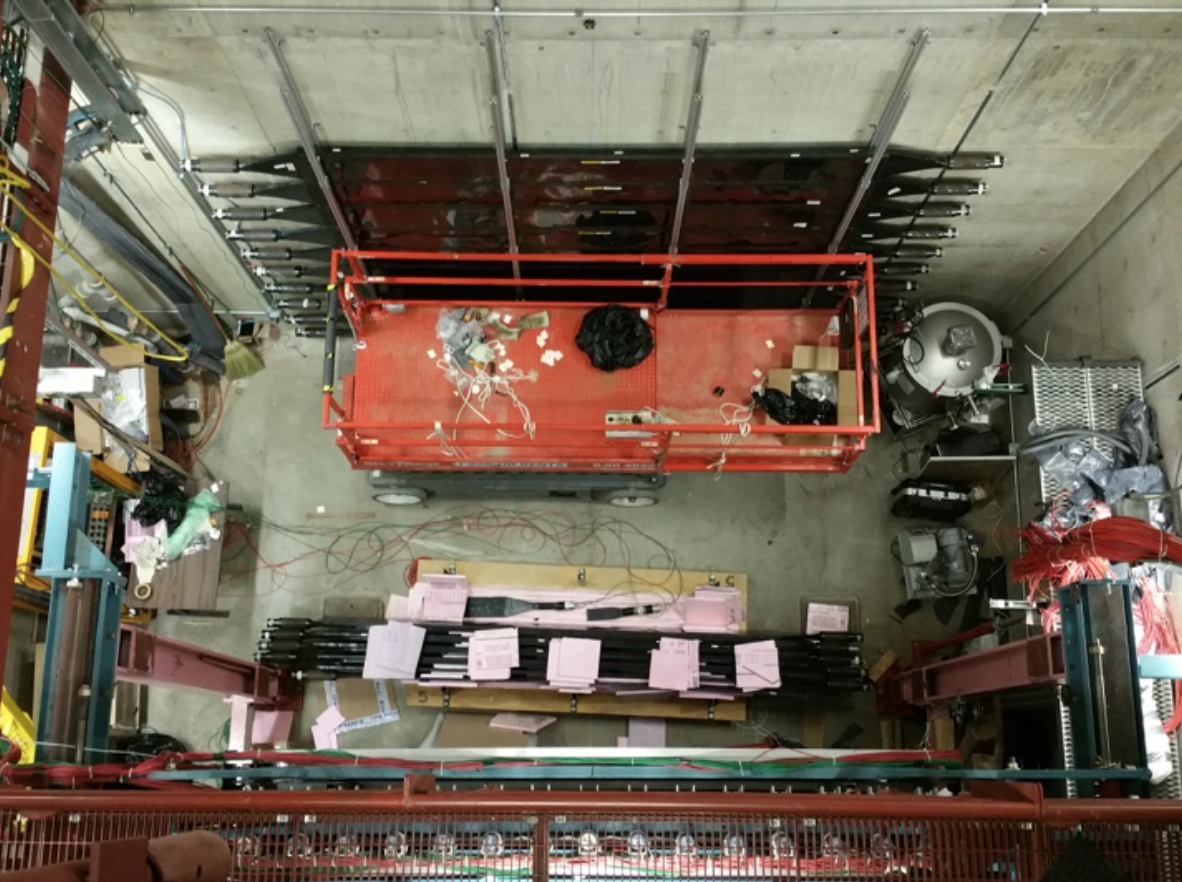 The FACC consists of two layers of horizontal plastic scintillator paddles stacked vertically in order to completely cover the cross section of the water tank upstream. Its main purpose is to detect muons created by neutrino interactions in the rock upstream of the hall and passing through the water tank, in order to tag subsequent events in the detector as not originating from neutrino interactions on water.
The FACC consists of two layers of horizontal plastic scintillator paddles stacked vertically in order to completely cover the cross section of the water tank upstream. Its main purpose is to detect muons created by neutrino interactions in the rock upstream of the hall and passing through the water tank, in order to tag subsequent events in the detector as not originating from neutrino interactions on water.
The Muon Range Detector (MRD)
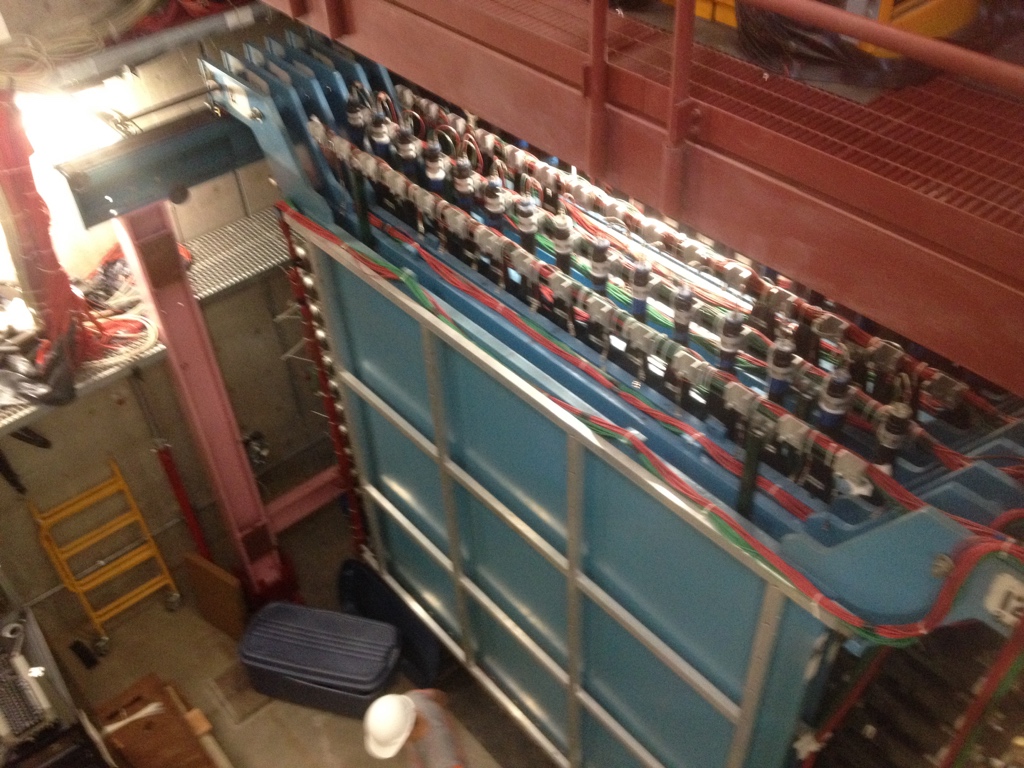 A legacy of the SciBooNE experiment, the MRD consists of twelve iron plates, each sandwiched by two layers of plastic scintillator paddles, alternatively arranged in an horizontal and vertical fashion. Its main purpose is to measure the energy and direction of muons exiting the tank, thus allowing reconstruction of the neutrino energy and momentum transfer.
A legacy of the SciBooNE experiment, the MRD consists of twelve iron plates, each sandwiched by two layers of plastic scintillator paddles, alternatively arranged in an horizontal and vertical fashion. Its main purpose is to measure the energy and direction of muons exiting the tank, thus allowing reconstruction of the neutrino energy and momentum transfer.
The Neutrino Target Tank
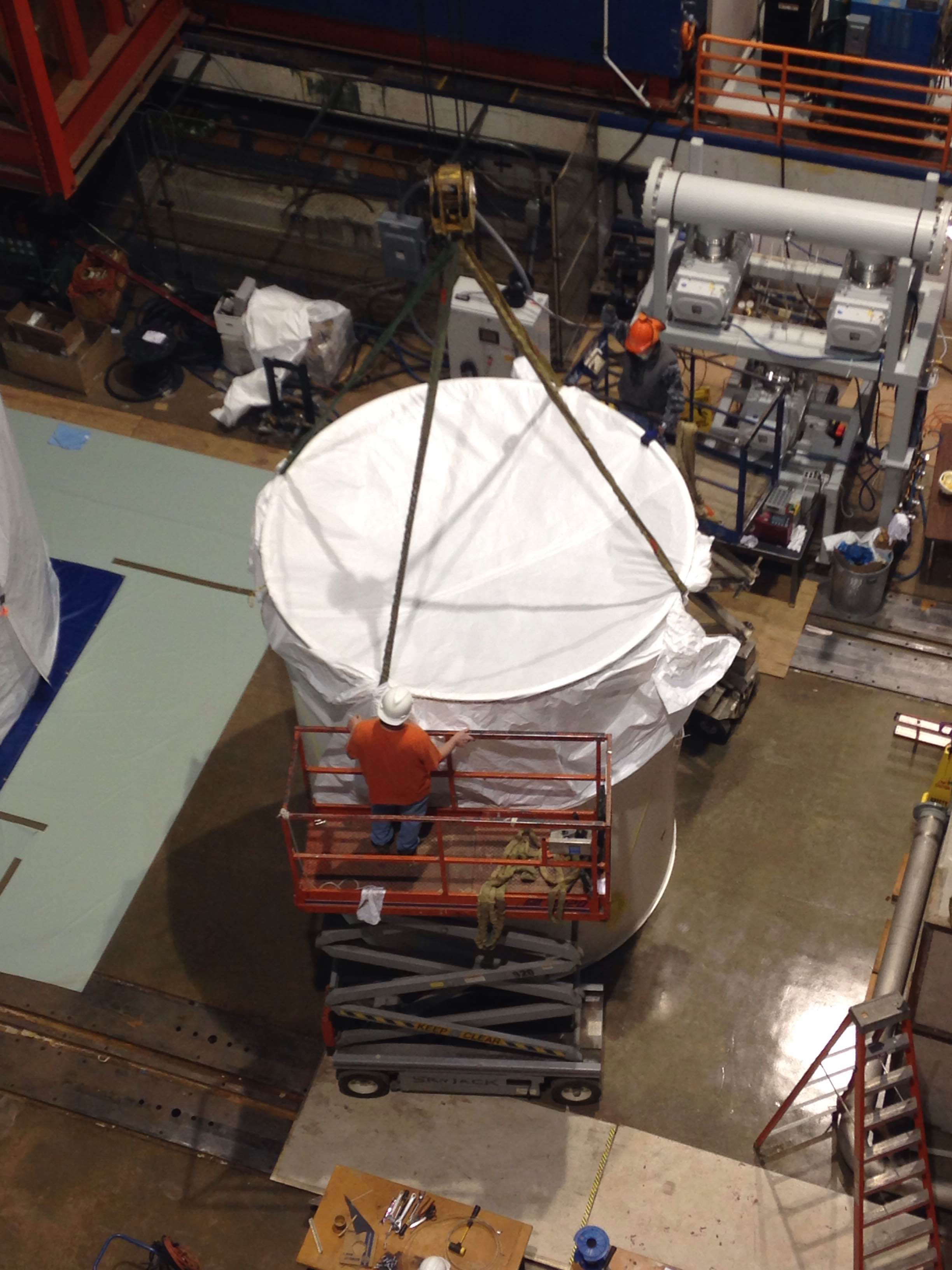 The water volume is the core of the ANNIE detector and consists of an upright cylinder (10’ x 13’) filled with 30 tons of pure water loaded with gadolinium sulfate (0.2% by weight). While muons created by neutrino interaction on oxygen nuclei can be reconstructed in terms of energy and angle using the Cherenkov light they generated in water, neutrons can be detected upon their capture on gadolinium, which emits a cascade of several gamma rays with a combined energy of about 8 MeV. The tank is covered with photomultiplier tubes (PMTs) and will be instrumented with LAPPDs (for their first live test in a neutrino experiment) during the physics phase.
The water volume is the core of the ANNIE detector and consists of an upright cylinder (10’ x 13’) filled with 30 tons of pure water loaded with gadolinium sulfate (0.2% by weight). While muons created by neutrino interaction on oxygen nuclei can be reconstructed in terms of energy and angle using the Cherenkov light they generated in water, neutrons can be detected upon their capture on gadolinium, which emits a cascade of several gamma rays with a combined energy of about 8 MeV. The tank is covered with photomultiplier tubes (PMTs) and will be instrumented with LAPPDs (for their first live test in a neutrino experiment) during the physics phase.
How ANNIE Works
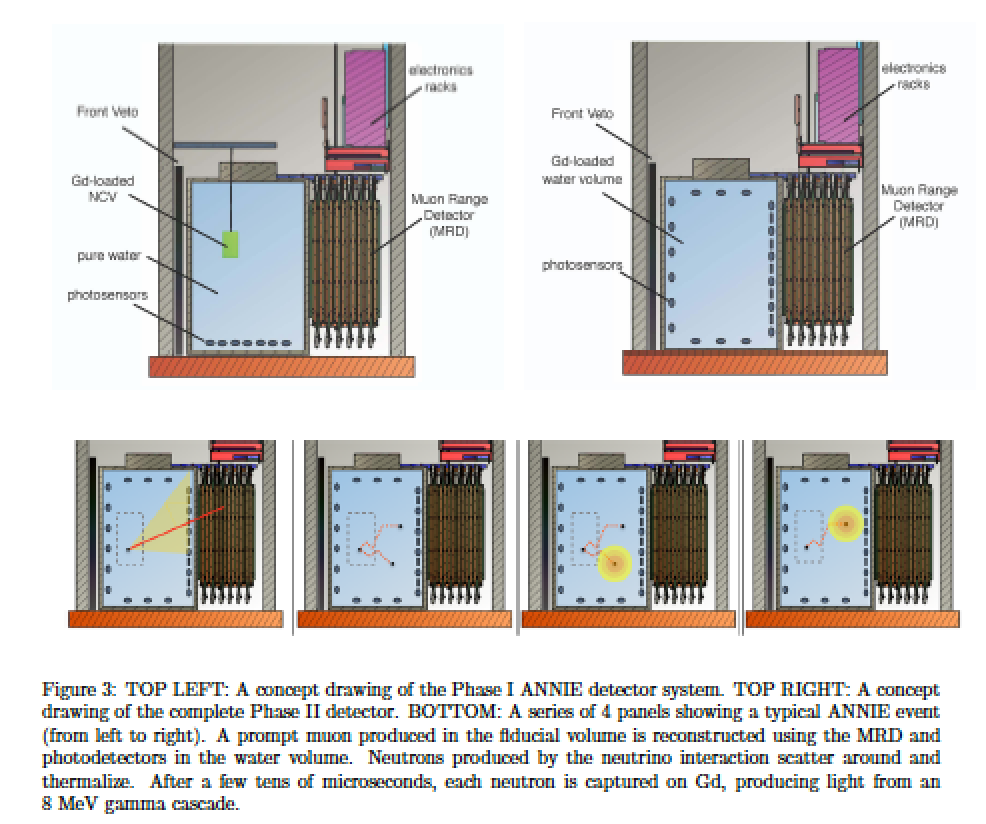
Phase 1 (Background phase: Completed in 2016-2017)
The neutron background can be separated into two categories:
- Skyshine neutrons: Originated from muonic and hadronic interactions in the beam dump, skyshine neutrons travel through the air and can scatter into the experimental hall.
- Dirt neutrons: Neutrinos interactions occurring in the rock upstream of the hall produce neutrons that reach the ANNIE detector.
For Phase 1, only a smaller subvolume within the tank is neutron-sensitive: the Neutron Capture Volume (NCV). It consists of a transparent cylindrical acrylic vessel (50 cm x 50 cm) filled with about 100 liters of gadolinium-loaded liquid scintillator. The high light yield of the liquid scintillator allows an efficient detection of neutron captures at different positions within the tank filled with ultra-pure water (see a picture of the NCV before installation below). The plot below shows the signal seen in the NCV as a function of time near the top of the tank (blue) and near the center (red). The large peak occurs at the time the neutrino beam crosses the detector and is caused by fast neutrons scattering off protons in the NCV liquid scintillator. The long tail is due to neutron captures in or near the NCV. These data show that the water in the top of the tank is sufficient to shield the central fiducial volume in ANNIE Phase 2.
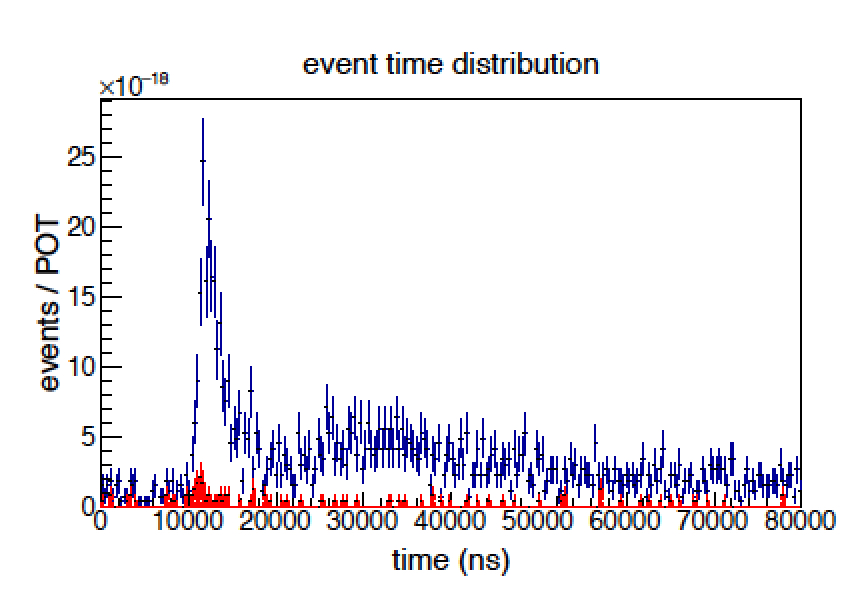
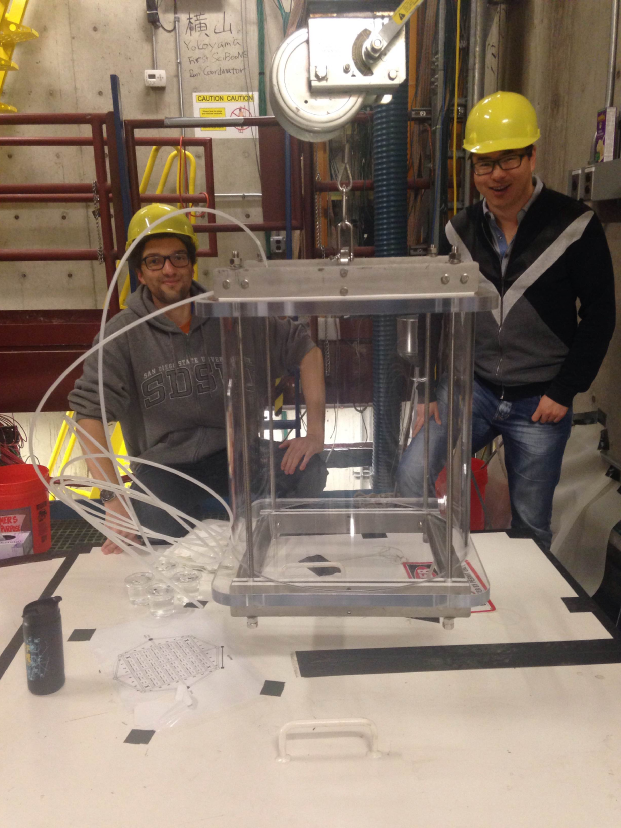
Phase 2 (Physics phase: Projected Start Summer 2018)
For Phase 2, the tank will be filled with Gd-loaded ultra-pure water in order to be fully sensitive to neutron captures. To increase the light detection efficiency, additional PMTs will be installed in the tank and, along these ~125 PMTs, several LAPPDs will be covering the walls of the tank.
Used as a veto and muon tagging tool in Phase 1, the MRD will be fully refurnished and regain its splendor from the old SciBooNE days. With 10 layers of plastic scintillator paddles, it will provide efficient and precise muon track reconstruction.
The future of ANNIE
ANNIE has two upgrade paths under discussion: (1) filling the detector with Water-based Liquid Scintillator (WbLS) to improve neutron efficiency and light yield, and (2) adding more LAPPDs to make more sophisticated multi-track reconstruction. These are referred to as "ANNIE Phase 3"
Interesting documentation (articles, talks, etc..)
The ANNIE Letter of Intent: https://arxiv.org/abs/1504.01480
The history of LAPPDs: https://arxiv.org/abs/1603.01843
The ANNIE webpage: http://annie.fnal.gov/
The ANNIE Run 2 PAC presentation: http://lanl.arxiv.org/abs/1707.08222
